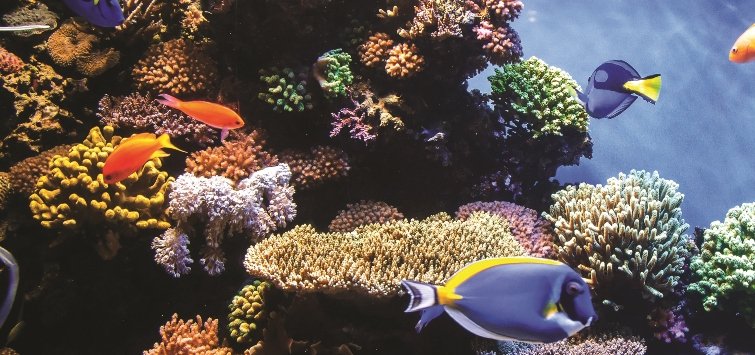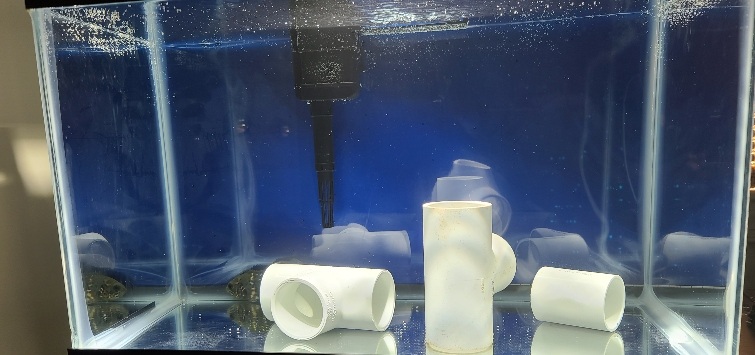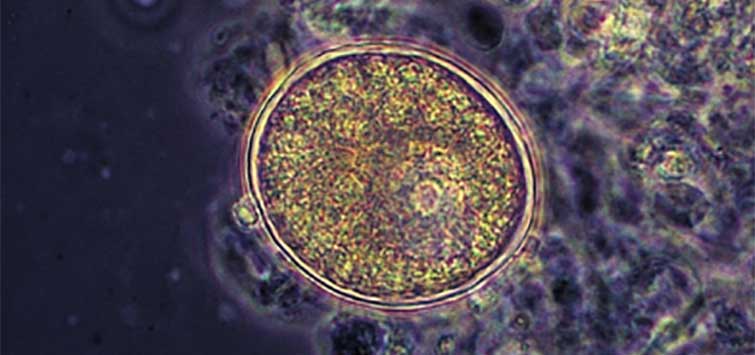How to Quarantine Saltwater Fish
Author: Jay Hemdal
It happens all the time: An aquarist acquires a new, seemingly healthy fish and adds it to their main display aquarium, only to watch a major disease outbreak occur within a few days or weeks. Maybe the new fish introduced the disease. Maybe the new fish caused enough stress in the environment to allow an existing, latent disease to become deadly. Or maybe it was just an unfortunate coincidence, also known as bad luck.
Whatever the reason, no aquarist wants to see a tankful of fish sickened or even wiped out by disease. To help prevent such a tragedy, you should quarantine saltwater fish prior to their introduction into an aquarium housing other fish.
Fish quarantine protocols require some compromise between effectiveness, amount of effort, and the safety of the animals themselves. At one end of the spectrum is the easiest course of action but, obviously, the least effective: not quarantining the fish at all. At the other end is a very comprehensive quarantine protocol that can last months, involve a wide variety of medications, and include the consultation of veterinary services to determine that the fish are free of all disease. A middle-ground approach is best for most aquarists. Combining visual cues from the fish with uncomplicated but effective prophylactic treatments will allow you to add fish more safely to an established aquarium.
General Fish Quarantine
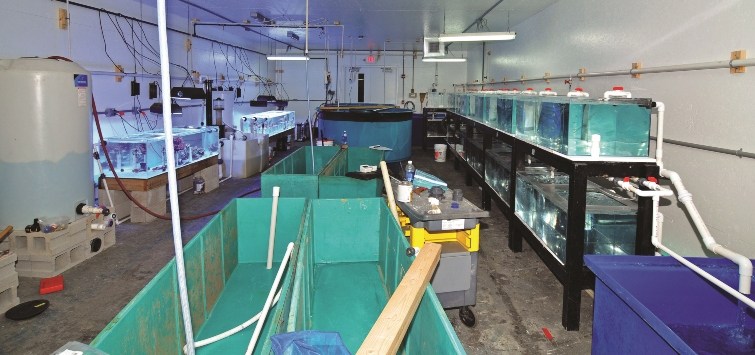
The process outlined here works well in most cases, with minimal risk to the newly acquired fish, but be prepared to modify the procedure if circumstances require it. Remember that many diseases can be transmitted on wet surfaces and as droplets through the air, so it’s important to disinfect tank tools that are used in more than one system—or use a dedicated set of tools for each system—and avoid locating quarantine fish tanks close to any main aquariums.
Step 1
The quarantine system must be set up before acquiring any new fish. Many aquarists find it helpful to establish a biological filter in their main aquarium a month or so before transferring it over for use in the quarantine system. Sponge filters and canister filters work very well for this purpose.
A basic quarantine system consists of an aquarium large enough to temporarily house the fish you intend to acquire, a tank cover, aeration, a heater, a biofilter, and some inert hiding places, such as pieces of PVC pipe. Do not use any calcium-based materials, as these will interfere with copper treatments if they’re needed.
The true volume of the quarantine fish tank needs to be determined. This is often less than an aquarium’s advertised volume (or it could be more, if there is a sump attached to the system). The most accurate means of determining the volume of an aquarium system is to measure the amount of water it takes to fill the total system, with all decorations in place, up to its normal water level. If that isn’t possible, the aquarium volume can be calculated by measuring the volume of the system in cubic inches and dividing by 231 to determine the volume in gallons.
Step 2
Begin an antiprotozoal treatment. The three common options for this include organic copper, ionic copper, and chloroquine. Most beginning and intermediate aquarists should use the organic copper option. Public aquariums often use the ionic copper method, while some advanced aquarists have been experimenting with using chloroquine for this stage.
Organically chelated copper quarantine: Various copper medications are available that contain copper chelated (bound) to an organic chemical. This makes the copper less toxic to the fish and more stable in solution. Basically, you add the medication once and then add more only if partial water changes are made.
One drawback to these medications is that they work fairly slowly and may not eradicate an active disease in time to save all the fish. Another drawback is their proprietary nature; manufacturers do not disclose how they are made, so it is difficult to choose one brand over another. Use your dealer’s advice to select a product. Finally, they work best as a preventative and, like ionic copper, cannot be used with invertebrates present.
Organic copper is added to the aquarium for a treatment length of at least 30 days. Because Step 3 needs to begin sooner than that, it will need to be run concurrently.
Ionic copper sulfate quarantine: This method requires a source of ionic copper and a good-quality copper test kit. The copper concentration is slowly raised to between .18 and .21 ppm ionic copper and maintained at this concentration for 14 days. No chemical filtration should be used during this treatment (including carbon and ion-exchange resins). The copper level should be checked twice daily with a porphyrin test kit and partial doses added to maintain the proper concentration at all times. Be aware that if the aquarium has been exposed to an organically chelated copper medication in the past, any residual copper will interfere with the ionic copper test.
During the treatment, watch the fish closely for signs of copper toxicity. Unfortunately, these signs are almost identical to the symptoms of many protozoan diseases (including scratching, rapid breathing, pale coloration, copious mucus production, and cloudy eyes), so care must be taken to ensure that copper toxicity is actually the problem. Sharks, rays, mandarin fish, pygmy angelfish, seahorses, and jawfish are some of the species known to be sensitive to copper levels as low as .15 ppm. Invertebrates have differing sensitivity to copper, but most cannot tolerate copper ion concentrations above .005 ppm.
At the conclusion of the treatment, the copper concentration can be allowed to drop on its own, or you can remove it via chemical filtration or partial water changes.
Chloroquine quarantine: Chloroquine is reportedly used at a wide range of concentrations, from 5 to 20 mg/l. This huge range is likely a result of too few studies being performed to truly determine what is the best dosage.
A 5 mg/l dose should be used as a quarantine preventative (not for active diseases) or for treating delicate species (although little is known about the sensitivity of different fish species to this medication). A dose of 8 mg/l is considered the “standard dose” for treating most active protozoan infections, while the 20 mg/l dose would be reserved for attempting to eradicate difficult-to-treat Uronema marinum infections. Toxicity in some fish species has been reported at doses above 15 mg/l. Wrasses, surgeonfish, and lionfish seem to be sensitive to chloroquine. The length of a typical chloroquine treatment is 14 days (as a preventative) to 30 days (for an active infection).
Chloroquine is also toxic to many invertebrates, algae, and bacteria. Seriously high ammonia levels (greater than 1 mg/l NH3-N) are sometimes seen a few days to a week after dosing an aquarium with chloroquine. It is unknown why this is seen in some aquariums but not others. One hypothesis is that the chloroquine has a direct antibiotic effect on the nitrifying bacteria. Another idea is that the chloroquine kills so much microscopic life in the aquarium that the beneficial bacteria are overwhelmed and an ammonia spike develops. Most likely, the cause is a combination of both factors.
Always monitor the ammonia levels in aquariums during treatment with chloroquine. Never expose aquarium water treated with chloroquine to ultraviolet light, either through UV sterilization or natural sunlight. It is suspected that UV reacts with chloroquine to create compounds that either are toxic to the animals or reduce the effectiveness of the treatment—or both.
Step 3
Begin a treatment for metazoan worms. These infections are very common but take longer to cause fish loss, so antiprotozoal treatments are administered first. The worm treatment of choice is praziquantel. The typical treatment is to dose it at 4 mg/l, then, after 72 hours, change 50 percent of the water, re-dose, and wait another 72 hours. A third treatment is usually needed to break the lifecycle of the parasite.
Praziquantel is not very soluble in water, so it needs to be mixed by hand. Wearing rubber gloves and a dust mask, place the proper amount of praziquantel into a brine shrimp net (or even pantyhose) and partially submerge the net in the aquarium. Gently knead the net so the fine particles of the drug drift out into the aquarium. Continue the process until you have expressed all of it into the water. Then, invert the net and give it a final rinse in the aquarium water. There are proprietary formulations of praziquantel on the market that may be easier to dose than the pure powder, but the resulting drug concentration may not be easily determined due to their proprietary nature.
Another possible worm treatment is the “dip-and-move” method, whereby fish are given a 166 mg/l formalin dip for 45 minutes (with aeration) and then moved to a new aquarium for 24 to 48 hours. This process is then repeated as many times as practical. Using two tanks that are cleaned out between uses, this process can be repeated many times. A minimum of six moves is suggested.
Step 4
At the end of any quarantine procedure, the fish should be observed for a minimum of 14 days prior to moving them to an aquarium containing established animals. During this time, the fish should be watched for other possible problems, such as bacterial diseases and internal parasites. Suitable treatments should follow the positive identification of any of these other problems.
Never rush to place specimens into a main aquarium after quarantining. These methods are not infallible, and a delay after the conclusion of the procedure acts as a safety net to allow time for any remaining diseases to develop and be treated outside the main system. Quarantining new fish is time-consuming and expensive, but it is well worth the effort in terms of overall lower mortality over time.
An Important Note
Capsalid flukes, such as Neobenedenia melleni, are relatively large (up to 8 mm) egg-laying worms that live on the skin or eyes of marine fishes. They are resistant to copper and praziquantel treatments, so the basic saltwater fish quarantine protocol outlined here will not be effective in treating this problem. These infections peak slowly; there may be no symptoms for many weeks after you acquire a fish. Eventually, as the flukes multiply and grow in size, they begin to cause symptoms of disease: cloudy eyes, “flashing,” and rapid breathing.Barrett Christie, a public aquarium curator, has researched a variety of treatment methods and struck upon one that is highly effective. The treatment is relatively simple: In a quarantine system, the fish are exposed to hyposalinity (low salinity) for 35 days. This kills the adult flukes and keeps the eggs from hatching. Exactly how low of a salinity is the variable that needs to be controlled. Some marine species do not tolerate lower salinities, yet if the salinity is not reduced enough, the parasite population is only reduced, not eradicated.
Barrett has hit upon a workable value of 17 parts per thousand, a bit less than half the salinity of normal seawater. Obviously, most invertebrates cannot be present during this sort of treatment. Sharks and some rays cannot tolerate this treatment, either. Assuming the fish are healthy in all other respects, you begin this treatment by lowering the salinity to the target value over 24 to 48 hours. During the low-salinity treatment, water quality must be monitored closely, especially pH.
Be aware that some other diseases, notably Uronema and Amyloodinium, thrive at lower salinities. Luckily, another common scourge, marine ich, Cryptocaryon irritans, is inhibited by low salinity. After 35 days, the salinity is gradually raised back to normal. It is imperative to perform this change back to normal seawater very slowly. While marine fish tolerate a drop in salinity very well, their kidneys have more difficulty adjusting as the salinity is raised. Never return fish to normal salinity sooner than 72 hours, and don’t make large changes all at once.
Observational Quarantine
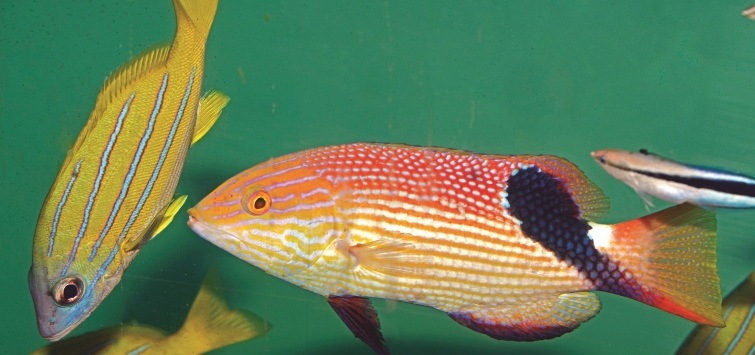
“Observational quarantine” is a term for when an aquarist does not want to expose a new specimen to any procedure more drastic than environmental control and observation pending the development of any obvious disease symptoms. This technique should only be used for extremely delicate fish, such as flashlight fish, or fish that do not normally transfer diseases to bony fishes, such as sharks and rays.
First, the specimen is placed into an isolation tank and observed for signs of disease for a period of 30 days. The difference between this technique and no quarantine at all is that the problem of disease transfer is minimized on a case-by-case basis in choosing “low-risk” or “low-value” tankmates. In addition, the operative word “observational” is very important. At least twice daily, the animal must be inspected closely for signs of developing problems. Please do not fall into the lazy habit of routinely using this technique simply because it is easier—because it is certainly not very effective.
Biological Controls
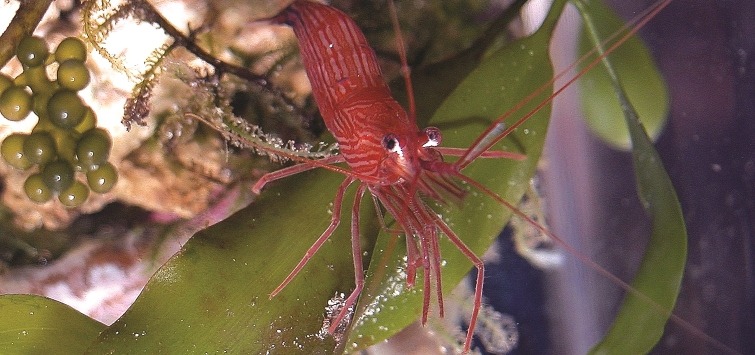
Many aquarists acquire cleaner wrasses (Labroides dimidiatus), neon gobies (Elacatinus spp.), or cleaner shrimp (Lysmata spp. and several others) in the hope that these animals will clear their fish of parasites. This process usually does not work for acute infections, and it is simply never effective for bacterial or protozoan infections. However, with some large parasites, notably copepods and Neobenedenia, partial control may be seen.
“Who cleans the cleaner” is an issue here, however. During active infections, the cleaner wrasse and neon gobies are susceptible to the very same diseases affecting the rest of the fish in the aquarium. Cleaner wrasses from the Philippines and Indonesia are notoriously delicate in captivity, with 40-day mortality rates typically above 90 percent. If you wish to experiment with this fish as a disease control method, only acquire cleaner wrasses that have been collected off the east coast of Africa or Australia—for some reason, they survive much better in captivity.
An Ounce of Prevention
Saltwater fish quarantine is an important step to take before adding any marine fish to a main display system. Combining close observation of a newly arrived fish in an isolation tank with simple-yet-effective prophylactic treatments will go a long way to allowing the new specimen’s eventual safe addition to your established aquarium. Just be ready to react to any emerging developments and be prepared to ramp up your procedures if circumstances dictate.As the old saying goes, an ounce of prevention is worth a pound of cure, and this is especially true when adding new fish to a marine aquarium.

.png?h=595&iar=0&w=2781&hash=5FD5E69473BCC22199FBFA2FB71B6033)
